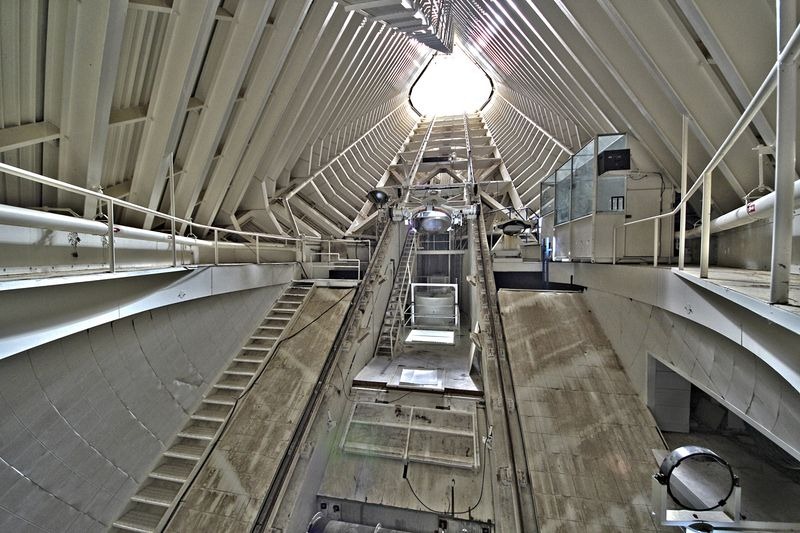The McMath-Pierce Solar Telescope at Kitt Peak National Observatory in Arizona, USA, looks like a monumental piece of modern art. A great white, inverted-V like concrete structure rises 110 feet up towards the sky from which a shaft slants two hundred feet to the ground. At the top of the tower is a 3-mirror heliostat which collects the sun’s light and directs it down the diagonal tunnel which continues for another three hundred feet into the mountain, forming an underground tunnel. At the base of the tunnel is a 34-inch parabolic mirror that captures the image of the sun. Built in 1962, it is the world's largest solar instrument as well as the largest unobstructed aperture optical telescope, with a diameter of 1.6 meters. Although designed to study the sun, it is so sensitive that it can even observe bright stars in the night.

Aerial view of the McMath-Pierce Solar Telescope. Photo credit: prezi.com
In addition to the primary mirror, there are also an East- and West-auxiliary telescope which are completely independent of the main telescope and are equipped with their own heliostats and mirrors. Instruments inside the underground facility include a dual grating spectrograph capable of extended wavelength coverage (0.3-12 microns), a 1-meter Fourier Transform Spectrometer for both solar and laboratory analysis, a high-dispersion stellar spectrometer, and bunch of other detectors.
The telescope’s observation room and instruments are located underground to avoid the temperature fluctuations that occur aboveground. The heliostat that is exposed at the top of the tower is protected by a steel jacket and a cooling system.
The McMath-Pierce Telescope is used to study the structure of sunspots, as well as sunspot spectra. Important discoveries made with this telescope include the presence of water and isotopic helium in the sun, solar emission lines at 12 microns, first measurement of Kilogauss magnetic fields outside sunspots and the very weak intra-network fields, first high resolution images at 1.6 and 10 microns, as well as detection of a natural maser in the Martian atmosphere.
The telescope is named after astronomers Robert McMath and Keith Pierce. At its dedication in 1962, Dr. Waterman read a letter from President Kennedy which began:
“The great new solar telescope at the Kitt Peak National Observatory in Arizona is a source of pride to the nation. The largest instrument for solar research in the world, it presents American astronomers with a unique tool for investigating the nearest of the stars, our sun. This project is of exceptional interest to all our citizens...”

Photo credit: Daniel Ramirez/Flickr

Photo credit: Daniel Ramirez/Flickr

Photo credit: Daniel Ramirez/Flickr

Photo credit: Sam Howzit/Flickr

Heliostat of McMath Pierce Solar Telescope on Kitt Peak at Sunset. Photo credit: NSO/AURA/NSF

Photo credit: globenewswire.com

Interior view looking up the tunnel of the The National Solar Observatory McMath-Pierce Solar Telescope on Kitt Peak National Observatory. Photo credit: P. Marenfeld & NOAO/AURA/NSF

Photo credit: Harvey Barrison/Flickr

Photo credit: James Joel/Flickr

Photo credit: Sam Howzit/Flickr

Photo credit: Brazilfox/Flickr



Comments
Post a Comment